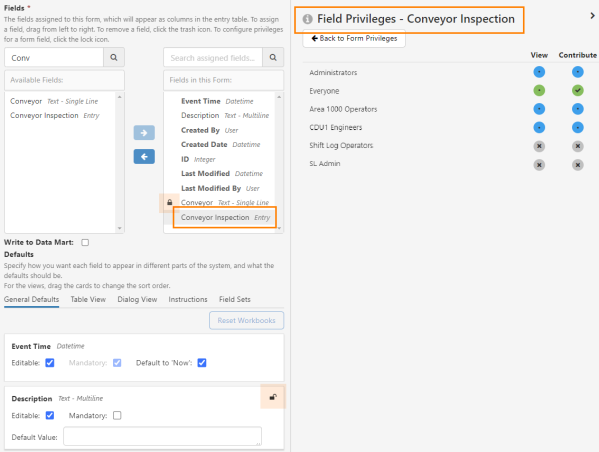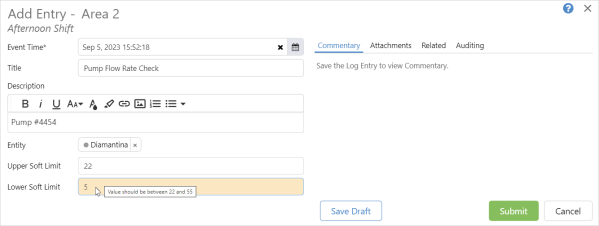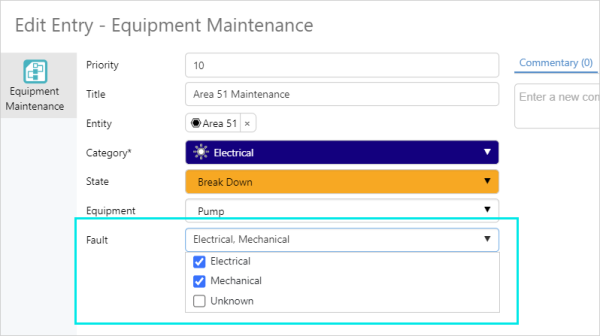ON THIS PAGE:
Shift Log version 4.13 adds the ability to configure multiple levels of conditional fields, auto fetch for tags, new related tab for entries and defaults for Workbooks.
Shift Log 4.13.2 adds a range of new components for use with Workbook studio, security for fields that are on a specific form, the use of attributes as soft limits for data entry fields and multi-select fields for field sets.
New Components Added to Workbook Studio
A collection of new components have been added to the Workbook studio, adding a range of chart types, display options and more. This greatly increases the components available for use when building a Workbook page.
|
Component Group |
Component |
Description |
|
Chart |
Area Chart |
Shows the change between a range of values compared to a second variable, typically that of time. |
|
Bar Chart |
Used to show and compare different types of information. |
|
|
Bullet Graph |
Comparison of two values in relation to one another in a horizontal bar chart. |
|
|
Line Chart |
Tracks changes over time. |
|
|
Scatter Chart |
Shows relationships between values in multiple data series. |
|
|
Stacked Area Chart |
Used to see how an item, plotted against multiple variables, changes over time. |
|
|
Stacked Bar Chart |
Shows comparisons between categories. |
|
|
Display |
Box Plot |
Shows the distribution of a set of data, using a Median and Quartiles. |
|
Data Label |
Displays time-aware tag and attribute values on Explorer pages. |
|
|
Info Button |
A clickable button used to give users knowledge about an associated area of the page. |
|
|
Status Indicator |
Displays different icons depending on whether set thresholds are reached. |
|
|
Status Tile |
Displays a value and is coloured according to the relationship between value and limit. It has a title and a description and can include a hyperlink. |
|
|
Text Label |
Used to display text on a page and optionally show variables. |
|
|
Layout |
Precision Layout |
Allows components to be positioned using x and y coordinates. |
|
Switch Layout |
Shows a different view according to what condition the variable matches. Uses the default view if none of the conditions are matched. |
|
|
Table |
Data Table |
A table that shows data in columns and rows. |
Individual Fields Secured on a Form
Security can be applied on a field-by-field basis to a particular form.
When multiple users interact with the same form, it may be the case that different groups of users require access to different fields on the form. Through adding field level security to forms, it is now possible for different users, or groups of users, to only see and/or contribute to specific fields on a form.
Security is applied to fields that are on a form and does not apply to the fields globally. In addition, security cannot be applied to a form’s required fields.
The Everyone role with Contribute privileges is the default security for new and existing form fields.
Clickable icons indicate form field security levels.
| The Everyone role has Contribute privileges; this means the field is not secured. | |
| The Everyone role does not have Contribute privileges. Roles have been individually assigned View and Contribute privileges for the selected field in the form. |
Note: For a field set to work correctly, users must be assigned Contribute privileges for all fields used in the field set.
Attributes as Soft Limits in Entry Forms
Extending the field soft limits functionality introduced in version 4.13.0, attribute values can now be used to determine the soft limits for attribute type data entry fields in entry forms.
The limits can be set when configuring Fields in Server Management.
From version 4.13.0, static values and tags can be added as soft validation limits to numeric data entry fields and used in all types of entry forms.
Multi-Select Field Added to Field Set
Multiple selections can now be made for the last field in a field set. This allows users to choose multiple options in chained combinations, for example selecting multiple sub-areas.
The final field in a field set can be multi-select, and this field is also the final field in the dialog.



